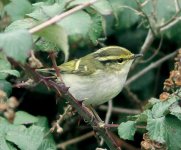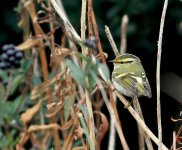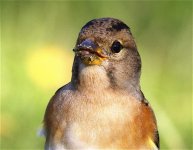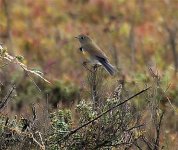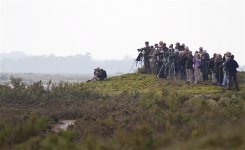Richard Abr
Well-known member
Different experience
Went to see the RFB and it was an "absolute stinker" to see this afternoon. Everyone coming away said it was showing well every 20 minutes or so, but in the two hours my wife and I were there it remained stubbornly hidden in thick cover for 99 per cent of the time. When we arrived two or three people were stood within a few feet of where the bird had last been seen, and apart from blocking the view they were perhaps stood to close. Birdguides have put it out, "avoid getting too close. Later when requested everyone did move back a bit. We saw it only on a couple of occasions flicking through the branches and twice sat perched in the cover at close range with the scope, but on the second occasion partly obscured by leaves.
At other times when the bird was showing in the cover unless you were stood in the right spot it was impossible to see it.
I suppose I can't grumble too much as I had fantastic prolonged views of the Alder Flycatcher on the Monday, a bird which I am less likely to ever see again.
To be fair the bird's extreme elusiveness this afternoon could be attributed to the fact that it had rained before we got there or more likely to the fact that it had fed really well earlier, rather than that people were stood in places where it had been seen in the open.
Anyhow no doubt there will be many more RFB's in future years, if the present trend continues.
Cheers
Richard
The Waxham RFB was showing beautifully today: down to five or six feet while I was there. Lots of Bramblings and Reed Buntings passing along the dunes, as well as six Cranes and two Buzzards.
Went to see the RFB and it was an "absolute stinker" to see this afternoon. Everyone coming away said it was showing well every 20 minutes or so, but in the two hours my wife and I were there it remained stubbornly hidden in thick cover for 99 per cent of the time. When we arrived two or three people were stood within a few feet of where the bird had last been seen, and apart from blocking the view they were perhaps stood to close. Birdguides have put it out, "avoid getting too close. Later when requested everyone did move back a bit. We saw it only on a couple of occasions flicking through the branches and twice sat perched in the cover at close range with the scope, but on the second occasion partly obscured by leaves.
At other times when the bird was showing in the cover unless you were stood in the right spot it was impossible to see it.
I suppose I can't grumble too much as I had fantastic prolonged views of the Alder Flycatcher on the Monday, a bird which I am less likely to ever see again.
To be fair the bird's extreme elusiveness this afternoon could be attributed to the fact that it had rained before we got there or more likely to the fact that it had fed really well earlier, rather than that people were stood in places where it had been seen in the open.
Anyhow no doubt there will be many more RFB's in future years, if the present trend continues.
Cheers
Richard
Last edited:




